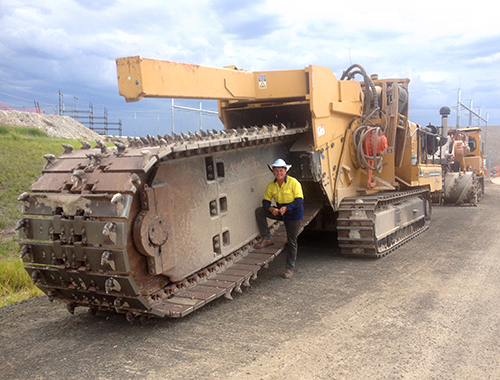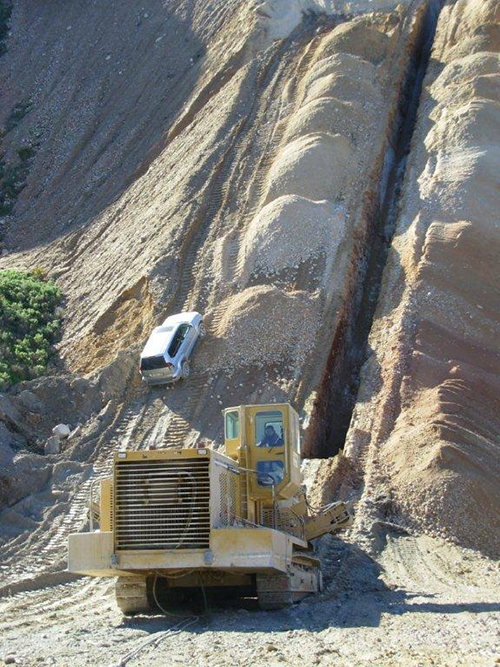Reviewing the small but powerful Digga Bigfoot chain trencher attachment has taken RON HORNER’s mind back to some bigger trenchers he’s operated over the years.
A couple of months ago, during a trip into western Queensland, I just happened to come across an old, retired piece of equipment that caused me to have one of those ‘stop and smell the roses’ moments.
I am sure we have all been there … you know when you are driving somewhere and out of the corner of your eye you see a piece of plant that just makes your heart skip a beat and takes you back to a time way back when life was so different.
Maybe you noticed it because it reminded you of the first machine you operated or one you owned at some stage of your life; maybe it was something that your dad may have had; or maybe you even just had something similar as a toy when you were a kid.
Your missus will never understand why you have to stop the car in the middle of the bush, in the stinking heat and flies and take photos, why you go all ‘gaga’ over a piece of old junk or why you want her to get out of the car to take a photo of you with it … this just happened to be one of those times.
What I found in the paddock was two old Cleveland bucket wheel trenchers — one was for spares but the other was quite complete.
 |
|
Ron Horner with a Cleveland 350 bucket wheel trencher as found in the paddock.
|
The Cleveland show
They took me back to over 40 years ago when I cranked up with Australian Pipeline Construction (APC) on the construction of the Moomba-to-Sydney gas pipeline.
I was offered a job on this project by a good old tobacco-chewin’ Yank with the biggest southern drawl I ever encountered — P J Hall, who was the Ditch Boss. He found me a position working in the trenching crew and manning a Cleveland 400 bucket wheel trencher, not too unlike the one I had just found it the paddock.
I was paired up and worked with some Victorian boys, namely Russell Tebbs, Stan Kells and ‘Needle Nose’, along with the crews of another two Clevelands (a 320 and a 400W).
These machines could out-dig anything around at the time — 1.6km a day, 2m deep and 1.3m wide (in good going). You couldn’t put them into hard rock because it would cost you a fortune in repairs but they would grind away in shale and softer mudstone and still make a good quid for the boss.
 |
|
A 1973 Cleveland 400W bucket wheel trencher as used on the Moomba-Sydney pipeline.
|
When you compare them to today’s trenchers you could say the Clevelands did have their drawbacks. A fully exposed and open cabin arrangement made sure you sweltered during summer, froze in winter, got covered in dust on most days of the year and got soaked on all the rest.
Operation of the bucket wheel (speed and elevation) and side discharge conveyor (two-way reversible) was through a series of cables operated from mechanical gearboxes and winches. The motive power came from two gearboxes similar to a high and low range, and a big diesel engine which sat way out front as a counterweight to compensate for the weight of the wheel at the rear of the machine.
That was way back in the mid-‘70s. The machines I had found in the paddock were considerably newer but not much had changed, really (though a fully enclosed cabin was one big improvement). This got my mind going and I recalled another project I found myself involved with where the key to making money was once again based around the production levels of a fleet of trenching machines.
 |
|
A Trencor 1260 hydraulic-drive chain trencher at work on the Queensland Gas Pipeline project north of Roma in 2013.
|
On the chain gang
On the Queensland Gas Pipeline project north of Roma in 2013 we used Trencor chain trenchers, which were a technological advancement on the bucket wheel trenchers.
The Trencors, in this configuration, could grind away at some pretty difficult rock, were extremely powerful and had high production levels, making them extremely cost effective.
The beauty of operating a trenching machine is not only the speed of the trenching operation as a whole but also the fact that the excavated material is ground up so finely that it can be utilised as a premium bedding or backfill material either prior to or after the pipe or cable has been installed into the trench.
These particular machines were a gem to operate, with air-conditioned cabins, radio, heater, some sound proofing (as long as you were deaf before entering the cabin), quality air ride seating, conveyor control and hydraulic elevating cabin for improved all-round operator vision. The Trencors could be optioned with mechanical or hydraulic drive and hydraulic chain operation.
But DON’T get them bogged — at close to 100 tonnes it can prove extremely difficult to get a suitable-sized machine out to a remote location to get you out.
You can see my video of the Trencor 1260HD chain trencher at work at the top of this page.
 |
|
Chain profilers like this Vermeer are both efficient and cost effective. That’s Ron again.
|
All sizes available
Of course trenching machines are not purely designed for opening up long distances of pipeline trenches. They come in smaller and larger sizes and have been modified considerably over the years.
Trenching machines (profilers) are now adapted to the mining industry and are proving, in some cases, to be more efficient and cost effective overall than engaging a drill, blast, win, load, haul and crush operation.
These machines can weigh in at over 150 tonnes and are fitted with an extremely wide cutting chain and grinding drums all fitted up with multiple rows of conical diamond-tipped teeth. These enable the profiler to cut/grind a swathe some metres wide over the open cut floor, creating a fine crushed/ground-up material in a windrow ready for it to be loaded out.
This material can be ground up so finely that it is possible to bypass the primary and secondary crushing phase.
Production rates are considerably lower for the winning of the material when engaging this type of mining operation but in some circumstances it proves to be more cost effective than more conventional methods. There are some of these machines working in the iron ore mines in Western Australia with BHP, and I believe Twiggy Forrest has some engaged in one of the Fortesque iron ore operations in the Pilbara.
 |
|
Chain Trenchers can be perfect for excavating steep declines.
|
As I said, these trenchers come in all shapes and sizes and over the last 20 years have been manufactured to adapt to numerous types of smaller, specifically designed plant as an attachment. Chain trenchers have been fitted to skid-steer loaders, backhoes and tracked loaders, and have even been designed to suit handyman-style backyard projects.
Do yourself a favour and check out my review of one of Digga’s Bigfoot trenchers attached to a 5-tonne Yanmar excavator here. This trencher is a bit smaller than what I have been used to operating but it’s a brilliant innovation and I had a blast operating it.
Click here to find trenchers for sale.

